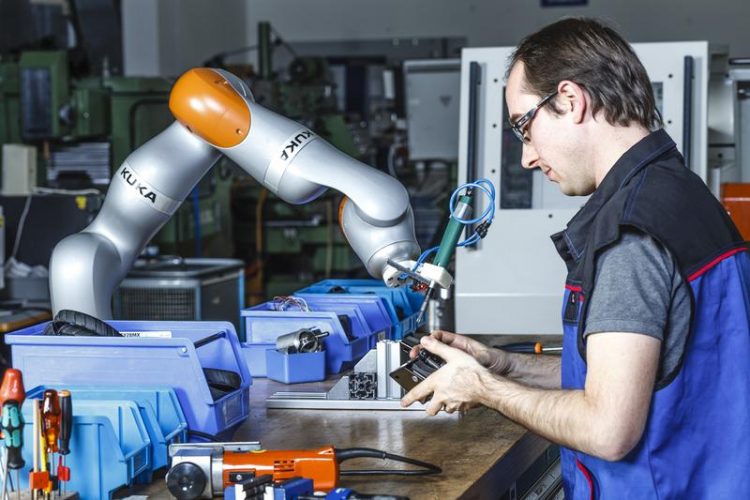Human-robot interaction: sensor-controlled assembly

Sensor-controlled assembly. Image credit: Fraunhofer IPA
The focus is on effective human-robot interaction at a workstation similar to those on a shop floor, the goal being to enable the worker to easily program the robot and use it intuitively like a tool.
Growing cost pressure, short product life cycles and high product diversity call for flexible and cost-effective assembly systems that can be quickly adapted to suit changed requirements. Scientists at Fraunhofer IPA have developed a sensor-controlled assembly process that makes it possible for workpieces to be localized and positioned.
Work-holding fixtures are extensively replaced by sensors, this offering flexibility at low cost. Other advantages are that the robot is designed to be easily programmable and capable of dealing with tolerances.
Using a robot as a tool
“Our aim is to demonstrate that sensor-controlled robots are capable of coping with modern-day conditions at manual assembly workstations, such as chaotically arranged components,” says Martin Naumann, Group Leader in the Robot and Assistance Systems department at Fraunhofer IPA. The emphasis is on effective human-robot interaction. Selected assembly processes are carried out manually, while others are automated. The robot is intended to be used as a tool.
At the joint stand of the European research initiative SMErobotics, Fraunhofer IPA will demonstrate sensor-controlled assembly in a robot cell with the KUKA LBR iiwa. “At a manual workstation, we’ll use the lightweight robot to carry out riveting processes as an example.
However, the underlying concepts can equally well be applied to other assembly processes,” explains Naumann. The components are made available within the robot’s working area without the need for any separate work-holding fixture.
The robot moves to the determined location and localizes the exact riveting position on the component using a stereo camera integrated in the robotic tool. “We’re highly interested in transferring the exhibited solution to new applications – especially at small and medium-sized manufacturing enterprises, where manual work processes prevail,” says Naumann.
More at Automatica – 6th International Trade Fair for Automation and Mechatronics
3 to 6 June 2014
New Trade Fair Centre Munich
Hall A4 | Stand 131
http://www.automatica-munich.com
http://www.ipa.fraunhofer.de
Media Contact
All latest news from the category: Power and Electrical Engineering
This topic covers issues related to energy generation, conversion, transportation and consumption and how the industry is addressing the challenge of energy efficiency in general.
innovations-report provides in-depth and informative reports and articles on subjects ranging from wind energy, fuel cell technology, solar energy, geothermal energy, petroleum, gas, nuclear engineering, alternative energy and energy efficiency to fusion, hydrogen and superconductor technologies.
Newest articles

Superradiant atoms could push the boundaries of how precisely time can be measured
Superradiant atoms can help us measure time more precisely than ever. In a new study, researchers from the University of Copenhagen present a new method for measuring the time interval,…

Ion thermoelectric conversion devices for near room temperature
The electrode sheet of the thermoelectric device consists of ionic hydrogel, which is sandwiched between the electrodes to form, and the Prussian blue on the electrode undergoes a redox reaction…

Zap Energy achieves 37-million-degree temperatures in a compact device
New publication reports record electron temperatures for a small-scale, sheared-flow-stabilized Z-pinch fusion device. In the nine decades since humans first produced fusion reactions, only a few fusion technologies have demonstrated…





















